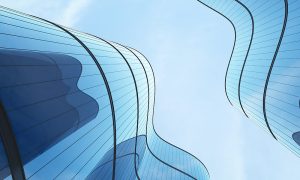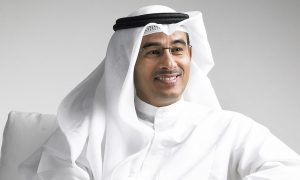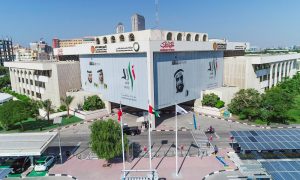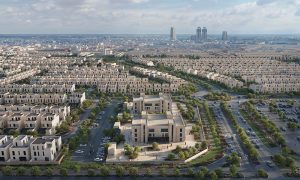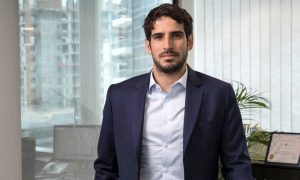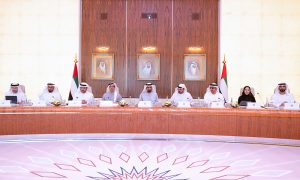Skidmore, Owings and Merrill: Scaling new heights in the Mideast
George Efstathiou and Uwe Nienstedt on the firm’s design philosophy

In concrete jungles like Dubai, it’s never an easy task for an architect to build a structure that stands out from the crowd. But right from the mid-1930s, designing an eye-catching structure has been a key selling point of every project by Skidmore, Owings and Merrill.
From the John Hancock Center in Chicago in the 1969 to the mammoth Burj Khalifa in Dubai, SOM’s legacy has not only been about designing iconic buildings but also about ensuring that each structure is sustainable.
Middle East Consultant took a walk down memory lane with George Efstathiou, consulting partner and Uwe Nienstedt, senior regional manager – MENA of Skidmore, Owings and Merrill to find out how their design philosophy has evolved over the years and what their plans are for the Middle East.
“We try to be selective with whom we work with and we’re always looking for good clients who have good vision and who will allow us to express what we do best,” notes Efstathiou.
“We design buildings that are not trendy and that stand the test of time. If you look at the National Commercial Bank building in Jeddah, it looks as fresh as it did 25 years ago and back then it was a sustainable project as well. Sustainability is not a new thing for us, being green is part of our design methodology and how we do it.”
“Our designs have a very strong connection between the architecture and the structure. If you take a look at the Haj Terminal at the Jeddah airport, it is basically a sustainable architectural solution but the structure is a major part and is a great example of architects and engineers working together. If you look at all of SOM’s work, it’s always deeply rooted in very strong conceptual and structural ideas.”
When it comes to the Middle East, SOM always has a wide range of architectural projects going on, says Efstathiou. The company has been working in the region since 1954, when it designed airfields in Morocco.
“Most of the best buildings SOM has designed have been in the Middle East,” Efstathiou reveals. “The Haj Terminal at the Jeddah airport and National Commercial Bank are two very good examples of our early work in the Middle East.”
“We then followed up with the design of Burj Khalifa with Emaar Properties PJSC in 2003, the Rolex Tower, Al Hamra Tower in Kuwait, the Cayan Tower in Dubai and Sheikh Khalifa Medical Centre in Abu Dhabi. We’re working on a few more projects with Emaar, and the newest one is Masreq Bank Headquarters in Dubai.”
“One of the projects worth mentioning is the Saudi Arabia projects. I just traveled there and both of these projects are looking great and have amazing quality,” says Nienstedt.
Stressing the importance of finding the right consultant-client match, Efstathiou recalls working on the Burj Khalifa and says it all began with a design competition.
“It started off by meeting Emaar on a Saturday in New York in the spring of 2003. Now we don’t normally have client meetings on Saturday, but we all went to visit them. We met in our New York office and showed them a few projects that we had done.
“I could tell right from the beginning that there was a very strong personal connection with them. To me, one of the most important things you can have is connections with people and being able to communicate with them. Soon after that, they invited us to a two-week paid competition. The original ideas for the Burj Khalifa were done in two weeks.
“At that time, I was on the phone with them every night just talking to them and trying to promote ourselves. Finally, one day I was told that they were interested in one of our schemes and they requested me to come to Dubai. Little did I know that SOM was selected and that’s something we joke about even today. We talked about it. I was on the phone with our partners in Chicago and sitting there with the client, we shook hands at the top of Emirates Towers and that was it.”
Bonds built on trust like this not only allow an architect creative freedom but also ensure a client comes back for more, the duo point out. They also stress on the importance of building execution and seeing a project through to the end no matter the role you play, and say that this commitment ensures a steady inflow of work.
Speaking about their project pipeline in the Middle East, Efstathiou says they have quite a few projects in the works including architectural and interior design projects and a couple more being planned.
“Some projects are in their early stages and are confidential, but we’re lucky enough to have repeat clients including the top developers in the region like Emaar, Meraas and Eagle Hills that continue to give us opportunities. They know they can depend on us for quality design and quality service,” says Efstathiou proudly.
“We’re not just paper architects, we don’t just draw the drawings and hand it off. We have a vested interest in seeing these buildings executed to the end, and our most successful story is the Burj Khalifa.”
“The client made three great decisions on the Burj – The first was to hire us, the second one was to allow us to do construction documents and allowing us to detail every inch of the building. The third one was to have a team of SOM architects in Dubai paying close attention to everything that was visible to the eye.
“We made sure that materials were selected by hand for everything and every detail was double-checked in the shop drawing phases and in mock-ups. We also did a lot of technical work as well, helping out the local consultants.”
Another big SOM project is The Capital Cairo, in collaboration with the Egyptian Ministry of Housing and Capital City Partners. SOM is leading the planning for this sustainable city, with the initial framework and core principles already decided.
The city will be built over 700 sq km and will house more than five million residents when completed. It will include 2,000 schools and colleges and more than 600 health care facilities.
“There are several levels of scale that we’re looking at. We’re looking at a 700 sq km site. We then simultaneously study smaller and smaller pieces until we get to a size that is more manageable so that you can start building the first phase,” says Efstathiou.
“The first phase and the highest priority is based on getting jobs there. After all, how do you build a new city? You have to create new jobs there for people to live and work, and that’s going to be one of the first issue that the government and our clients have to come to grips with.
“We went through at least a two- or three-month stage of getting ready for this announcement at Sharm El Sheikh. It was a very intense effort over a short period of time. The MoU was signed and then we went into a process of developing a programme for the scope of services so that we could start a more detailed master planning process.
“Now that we’ve completed the project planning we’re ready to go, but there are still negotiations that are going on between our client and the government of Egypt. So we’re waiting for those negotiations to be completed.”
Projects like this require a deep talent pool. SOM’s strategy has been to keep their design firms in their major offices in the United States and in London, while their office in Abu Dhabi takes care of business development and relationships in the region.
Efstathiou explains, “The reason why we have our brain trust in one spot is because we can control quality better when it’s all in one place rather than when it’s all dispersed. We see a lot of our competitors setting up satellite offices everywhere, and as a result their talent pool is diluted.”
“We’re constantly refreshing our talent base and most of the people we have are in our major offices in London, Chicago, New York, Los Angeles and San Francisco. We’re always looking for the youngest and brightest people. The best thing you can do is find someone who can think well.”
“Architects and engineers need to be thinkers first and not just people who can work on computers. A big difference between our firm and the local firms here is that all our staff are trained professionals at every level.
“Here in the Middle East, you have trained professionals at the top and then there are draftsmen who are basically drawing on a computer. With us, the thinking behind the design occurs at every level of our team. They understand exactly what the project is about and are not just drawing lines on paper.”
Nienstedt adds, “I think that is actually a differentiating factor between us and some of our competitors. What SOM also does is that they bring people up through the ranks. Everybody that you have on every level is somebody who wants to get ahead and is aspiring to grow within the firm.”
Asked about their market strategy for the Middle East, Efstathiou explains that they are set up to handle the region headed by a few people.
“We recently hired Uwe to strengthen our position here, and this is going to make a marked difference in our approach. Now we have a senior person here who has been through several different professions related to architecture, and that gives him much more insight into the practice of planning, architecture and engineering.”
In terms of consolidation, Efstathiou says that SOM would rather focus on what they do best and grow their firm internally focusing on consistency and design quality. “We’ve tried to expand our services at certain times, but we know that there are consultants who can do it better than we can, so we focus on what we do best and that’s what keeps us on top of the list.”
“If you look at the consolidation of some of these firms into one, I know I’ve had conversations with people about the fact that they’ve lost all of their identity as a firm within this big conglomerate and they’re not very happy. We’re very happy that we have a strong brand and we’re very focused on what we do, and everybody knows exactly what’s expected.”
Expressing his concern about the recent consolidation activity among consultants, Nienstedt says that the focus for a number of firms has become managing shareholder value. “Projects are managed by their income and not by the client expectation or by producing quality. I don’t think that’s the right KPI for a consultancy.”
“I think if you want to have repeat clients, sometimes you have to go the extra mile and cannot afford to worry about the cash flow at that particular moment. Eventually if you’ve done a good job you will recover, but some companies right now are purely driven by short-term cash flow.”
Talking about sectors that SOM will be looking closely at in the Middle East, Efstathiou notes that they always like to do a variety of work because it helps expand their minds and structures their imagination.
“We’ll be looking at doing more institutional work for corporate entities that are here. Health care and cultural buildings is something that we love to do because there’s a good building type where you can do something a little more experimental.
“Back in the States, we’re known as the father of modern office building, and that always was our bread and butter. Over the years we’ve expanded and diversified our practice to other building types.”
Highlighting SOM’s expansion plans, the duo indicate that the company is considering moving their office to Dubai from Abu Dhabi, though nothing has been finalised yet. They point out that they are already present in several markets globally.
SOM’s offices in Chicago, New York and Los Angeles take care of both North and South America, while their office in London handles their European needs. Further east, the firm has a base in Shanghai that looks after China and Southeast Asia.
The Indian market has also sparked their interest again, Efstathiou says. “We have a small office in India, but we withdrew because there was a bit of a downturn in work there and it wasn’t making sense for us. Now there are certain new reforms being put in place that is making it easier to do work, so I think you’ll see in the next six months a stronger commitment to that area.”
In the MENA region, SOM has been eyeing Iran and expanding operations in Africa. “I think we’re also going to be taking a good look at Africa. The other one on our radar which is a big question mark is Iran. It’s a country with a huge history and culture, and probably with a huge need for good architecture,” notes Nienstedt.
